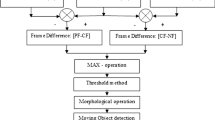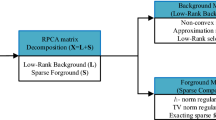Abstract
In order to extract the human moving object more accurately and efficiently in the surveillance video, a moving object detection algorithm combining smoothing frame difference method and Robust Principal Component Analysis (RPCA) is proposed. In view of the “shadow” and “cavity” problems in the traditional three-frame difference method, each frame image converted into a gray image is first divided into a fuzzy set such as a smooth region, a texture region and an edge region, and the smooth region can reduce the sudden change of the light. The effect on the gray value, that is, the smoothing frame difference method; RPCA can achieve both data dimensionality reduction and high noise, spike noise rather than Gaussian distribution noise. The two algorithms are used in combination, and the background of the current frame of the RPCA extracted video is used as the intermediate frame of the smoothed frame difference method, and is respectively differentiated from the previous frame of the current frame and the current frame of the video, thereby avoiding the background pixel point. The influence eliminates the phenomenon of “cavity” and also contributes greatly to the reduction of noise. Video detection experiments in different scenarios show that it is more efficient and accurate than similar algorithms.





Similar content being viewed by others
Change history
13 September 2022
This article has been retracted. Please see the Retraction Notice for more detail: https://doi.org/10.1007/s11042-022-13868-y
References
Barron JL, Fleet DJ, Beauchemin S (1994) Performance of optical flow techniques. Int J Comput Vis 12(1):42–77
Cao W, Yao W, Jian S et al (2016) Total variation regularized tensor RPCA for background subtraction from compressive measurements. IEEE Trans Image Process 25(9):4075–4090
Dai K (2006) Prospects and current studies on back-ground subtraction techniques for moving objects detection from surveillance video. Journal of Image and Graphics 11(7):917–919
Gao Z, Cheong LF, Wang YX (2014) Block-sparse RPCA for salient motion detection. IEEE Trans Pattern Anal Mach Intell 36(10):1975–1987
Guo J, Wang J, Bai R et al (2017) A new moving object detection method based on frame-difference and background subtraction. Materials Science & Engineering Conference Series 242(1):012115
Huang X, Huang P, Cao Y, et al (2013) A block-sparse RPCA algorithm for moving object detection based on PCP. Journal of ECJTU
Javed S, Jung SK, Mahmood A et al (2017) Motion-Aware Graph Regularized RPCA for background modeling of complex scenes. International Conference on Pattern Recognition
Lee D (2005) Effective Gaussian mixture learning for video background subtraction. IEEE Trans Pattern Anal Mach Intell 27(5):827–832
Meyer D, Denzler J, Niemann H (1997) Model based extraction of articulated objects in image sequences for gait analysis. Proceedings of IEEE International Conference on Image Processing, Santa Barbara, California, 78–81
National Institute of Standards and Technology (NIST) [On-line], available: http://www.nist.gov/index.html. 5 April 2016
Steiner JE, Menezes RB, Ricci TV et al (2018) PCA tomography: how to extract information from data cubes. Mon Not R Astron Soc 395(1):64–75
Text Retrieval Conference (TREC) [Online]: available: http://trec.nist.gov/. 5 April 2016
TREC Video Retrieval Evaluation (TRECVID) [Online], available: http://www-nlpir.nist.gov/projects/trecvid/. 5 April 2016
Zhang Y, Chen L, Jia J et al (2014) Multi-focus image fusion based on non-negative matrix factorization and difference images. Signal Process 105(105):84–97
Zhang J, Cao J, Mao B (2016) Moving object detection based on non-parametric methods and frame difference for traceability video analysis. Procedia Computer Science 91:995–1000
Acknowledgements
This work is supported by Shanxi Nature Science foundation(Grant No. 2015011040).The authors would like to thank the anonymous reviewers and the editor for the very instructive suggestions that led to the much improved quality of this paper.
Author information
Authors and Affiliations
Corresponding author
Additional information
Publisher’s Note
Springer Nature remains neutral with regard to jurisdictional claims in published maps and institutional affiliations.
Jinsheng Xing is the tutor of Jianguo Ju.
This article has been retracted. Please see the retraction notice for more detail: https://doi.org/10.1007/s11042-022-13868-y
Rights and permissions
Springer Nature or its licensor holds exclusive rights to this article under a publishing agreement with the author(s) or other rightsholder(s); author self-archiving of the accepted manuscript version of this article is solely governed by the terms of such publishing agreement and applicable law.
About this article
Cite this article
Ju, J., Xing, J. RETRACTED ARTICLE: Moving object detection based on smoothing three frame difference method fused with RPCA. Multimed Tools Appl 78, 29937–29951 (2019). https://doi.org/10.1007/s11042-018-6710-1
Received:
Revised:
Accepted:
Published:
Issue Date:
DOI: https://doi.org/10.1007/s11042-018-6710-1




